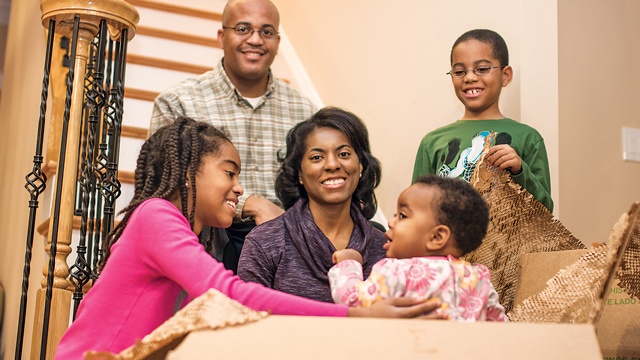As a young person, your first adult relocation is typically moving out of your parents’ home into a dorm, apartment, or even a house. I recall it being an exciting time when I moved into my very own apartment, a place I’d chosen based solely on my preferences and my needs. I didn’t have much to pack, and I was ready to go.
Fast forward to the present, and relocating is much different. Relocating means thinking about my own needs, as well as the needs and preferences of my husband and children. Packing is a huge project. A new home now means navigating the various emotions that everyone is feeling about leaving familiar faces and places.
My family recently moved – we all survived – and now I can share the things that worked for our family, as well as some lessons learned.
1. Get your children involved as much as appropriate.
Keeping children involved in the process helps them accept the change by providing them with more knowledge of what is to come.
Try taking your children along when you are looking at houses or apartments, or driving through new neighborhoods. We moved twice in one year, first into an apartment and then into a new house. Our kids accompanied us to see different apartment communities. It helped them feel like a part of the decision. They checked out the pool and playground at each place – and let’s face it, those are important amenities.
2. Spend time in your new surroundings as often as possible.
If it’s not too far from your current home, shop and dine in your new hood. If you are going to grab lunch at Chick-fil-A, pick the one near your new house. Or better yet, try out some new neighborhood spots that may become favorites. You can visit the new school and let the children play on the playground.
If you are moving to another city or state and this is not practical, make use of the Internet to show your children lots of pictures of your new town. Try scoping out local festivals or activities and put them on the calendar to attend, giving the kids something fun to anticipate.
3. Help kids develop a plan for keeping in touch with friends.
My daughter felt like she would never see some of her friends with whom she attended school. But when we talked it out, I reminded her that she could still have play dates. As we were moving across town, we would just drive a little further. Be in touch with the parents of friends to let them know you want to maintain the friendship, and you’ll see that those parents respond and help make it happen. We had some play dates scheduled early on, and it was helpful for our children. Kids don’t mind entertaining friends in a home that is still in disarray.
Make sure you apply this tip for yourself, too. As we transitioned to a new school, I missed the sense of community I felt at our old school, where I knew so many other parents and administrators. I realized that as much as I needed to forge new friendships, I also needed to stay connected with my old friends.
4. Try to limit too much change and chaos at once.
I can’t say I completely followed this guideline myself, so this is a lesson learned. In one year, we started construction on a new house, sold our home, moved to an apartment, changed schools, moved into a new house – and oh yes, our third child was born. I know that each of these transitions was for the long-term benefit of our family, but it was stressful at times.
To ease the craziness, we tried to minimize other changes whenever possible. We obtained a waiver from the county to allow our children to start the school year at the kids’ new school, even though it would be a while before we would actually live in the district. We were able to avoid a mid-year school change. After some butterflies in the tummy on the first day, my kids handled the school-change like champs.
While it meant a longer drive for me after work, I opted to delay the change in the kids’ after-school care. We believed that changing to a new school was enough for them, and remaining with the same after-school care facility allowed them to play with friends in a familiar environment each day. Our son continued to play with the same soccer league, which meant he would continue to play in the same park and would see old friends. The balance of familiar with new things helped tremendously.
5. Pack strategically.
You won’t get your new home set up perfectly in one day, but you can do enough to make the family feel comfortable in the new space quickly. I made sure to pack boxes and bags with what I called day-one items. I knew where to find the kids’ toiletries and favorite bath items. I also packed day-one items for their bedrooms, so I could at least get their familiar sheets and blankets out quickly, as well as favorite stuffed animals for the first night.
My children also did a fair amount of their own packing. They filled boxes with all of their toys, games, and other beloved junk, as I call it. This was helpful because they were able to remember what box held which things. And I was able to remind them of that when they asked me where something was!
With some careful planning and transitioning, moving to a new home with your family doesn’t have to be a negative experience. I learned that children can be very resilient and flexible, especially when they feel like they know what’s going on. Staying connected to the people and places that matter the most can make for an easier adjustment for everyone in the family.




